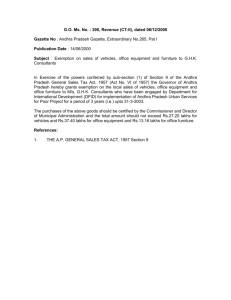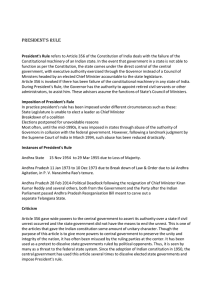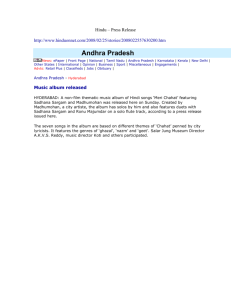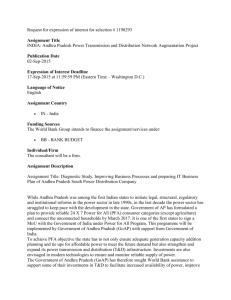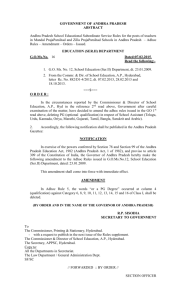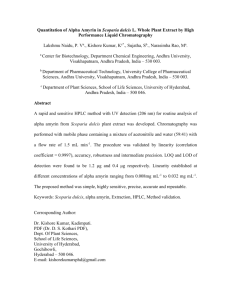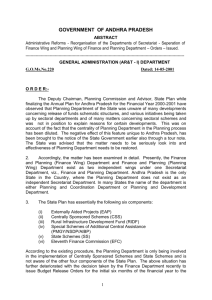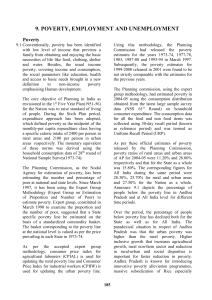Poverty, Employment and Unemployment
advertisement
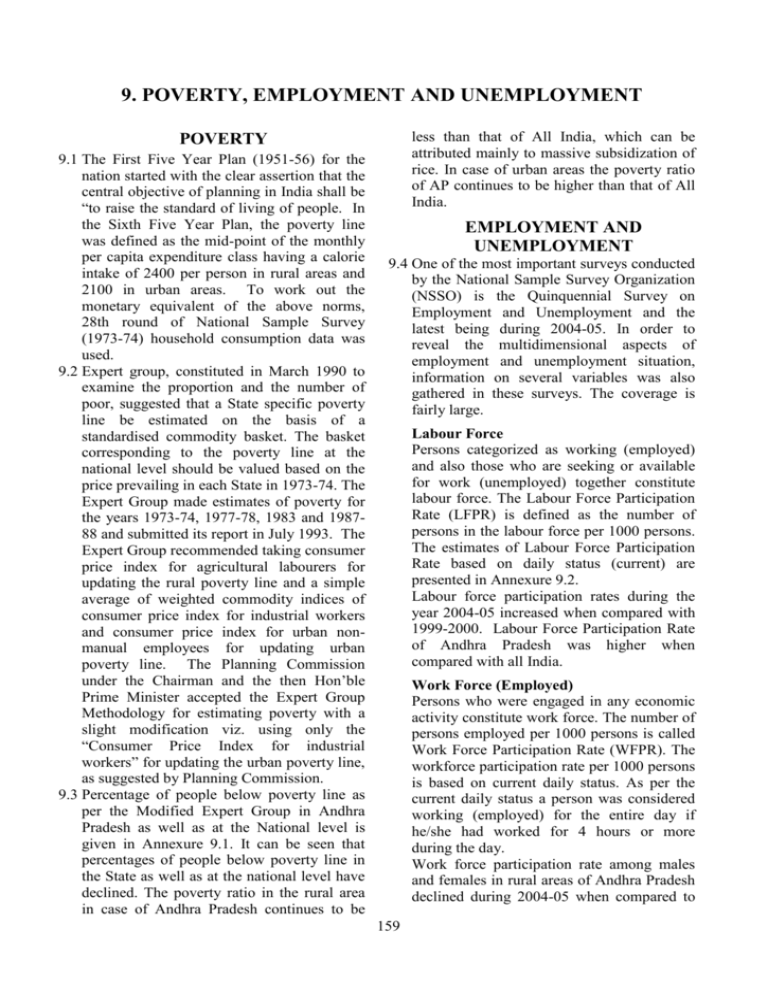
9. POVERTY, EMPLOYMENT AND UNEMPLOYMENT less than that of All India, which can be attributed mainly to massive subsidization of rice. In case of urban areas the poverty ratio of AP continues to be higher than that of All India. POVERTY 9.1 The First Five Year Plan (1951-56) for the nation started with the clear assertion that the central objective of planning in India shall be “to raise the standard of living of people. In the Sixth Five Year Plan, the poverty line was defined as the mid-point of the monthly per capita expenditure class having a calorie intake of 2400 per person in rural areas and 2100 in urban areas. To work out the monetary equivalent of the above norms, 28th round of National Sample Survey (1973-74) household consumption data was used. 9.2 Expert group, constituted in March 1990 to examine the proportion and the number of poor, suggested that a State specific poverty line be estimated on the basis of a standardised commodity basket. The basket corresponding to the poverty line at the national level should be valued based on the price prevailing in each State in 1973-74. The Expert Group made estimates of poverty for the years 1973-74, 1977-78, 1983 and 198788 and submitted its report in July 1993. The Expert Group recommended taking consumer price index for agricultural labourers for updating the rural poverty line and a simple average of weighted commodity indices of consumer price index for industrial workers and consumer price index for urban nonmanual employees for updating urban poverty line. The Planning Commission under the Chairman and the then Hon’ble Prime Minister accepted the Expert Group Methodology for estimating poverty with a slight modification viz. using only the “Consumer Price Index for industrial workers” for updating the urban poverty line, as suggested by Planning Commission. 9.3 Percentage of people below poverty line as per the Modified Expert Group in Andhra Pradesh as well as at the National level is given in Annexure 9.1. It can be seen that percentages of people below poverty line in the State as well as at the national level have declined. The poverty ratio in the rural area in case of Andhra Pradesh continues to be EMPLOYMENT AND UNEMPLOYMENT 9.4 One of the most important surveys conducted by the National Sample Survey Organization (NSSO) is the Quinquennial Survey on Employment and Unemployment and the latest being during 2004-05. In order to reveal the multidimensional aspects of employment and unemployment situation, information on several variables was also gathered in these surveys. The coverage is fairly large. Labour Force Persons categorized as working (employed) and also those who are seeking or available for work (unemployed) together constitute labour force. The Labour Force Participation Rate (LFPR) is defined as the number of persons in the labour force per 1000 persons. The estimates of Labour Force Participation Rate based on daily status (current) are presented in Annexure 9.2. Labour force participation rates during the year 2004-05 increased when compared with 1999-2000. Labour Force Participation Rate of Andhra Pradesh was higher when compared with all India. Work Force (Employed) Persons who were engaged in any economic activity constitute work force. The number of persons employed per 1000 persons is called Work Force Participation Rate (WFPR). The workforce participation rate per 1000 persons is based on current daily status. As per the current daily status a person was considered working (employed) for the entire day if he/she had worked for 4 hours or more during the day. Work force participation rate among males and females in rural areas of Andhra Pradesh declined during 2004-05 when compared to 159 1999-2000 whereas in urban areas of A.P., it increased. Work force participation rates in general are high in Andhra Pradesh when compared with all India. Details are shown in Annexure 9.3. these, 3123 establishments were in Public Sector and 5777 establishments were in Private Sector. In other words the no.of establishments in Public Sector was less than that in Private Sector. During the past 40 years, large-scale development has taken place in the Public Sector and the no.of establishments have rose upto 14171 by the end of March 2006, while the no.of Private Sector establishments stood at 8168, with the total in the organized sector being 22,339. In the case of employment in the organized sector in Andhra Pradesh during the past forty years, there was totally an increase of 10.44 lakh employees while the total no.of persons employed in organized sector in Andhra Pradesh was only 9.56 lakhs in 1966. It went up to 20.01 lakhs by the end of 31st March 2006. Number of employees in Public Sector which were only 6.56 lakhs up to the end of March 1966 increased to 13.75 lakhs by the end of March 2006. The no.of employees in Private Sector establishments which was only 3.00 lakhs in 1966, increased to 6.27 lakhs by the end of March 2006. It is significant to note here that while the no.of employees almost more than doubled or almost doubled in the case of the Public and Private Sector, respectively, during the last 40 years, the increase in employment in Public Sector was due to four fold increase in no. of establishments, while that in Private Sector was due to 30% increase in no.of establishments. In other words the existing establishments in Private Sector increased their employment without physical expansion horizontally. The no.of job seekers who registered in the Employment Exchanges in Andhra Pradesh during the year 1964 was 2.13 lakhs, while 37,944 vacancies were notified during that year to Employment Exchanges, and 35,875 candidates were placed in jobs. The total no.of candidates who finally remained on the Live Register at the end of 31.12.1964 was 1.31 lakhs. In the year 2005, as many as 3.47 lakhs candidates had registered their names in the Employment Exchanges. During 2005, 16,979 vacancies were notified and 2122 EMPLOYMENT The compound annual growth of employment in the State is significantly low when compared with that of All India. Employment elasticity, which reflects the responsiveness of employment generation to change in gross domestic product, is low in both Andhra Pradesh and All India. In case of Andhra Pradesh it is less when compared with All India (Table 9.1) Table 9.1 Employment Growth and Elasticity Employment Growth Andhra India and Elasticity Pradesh Compound Annual Growth Rate of 0.35 1.07 Employment (1993-94 to 1999-2000) Compound Annual Growth Rate of 2.65 4.43 Employment (19992000 to 2004-05) Employment Elasticity (1993-94 to 19990.07 0.16 2000) Employment Elasticity (1999-2000 to 20040.41 0.74 05) Source: - Economic Survey – 2002-03 GOI. Directorate of Economics and Statistics, Hyderabad EMPLOYMENT AND TRAINING Employment in Organized Sector The day-to-day administration of National Employment Service was transferred from Government of India to State Government in the year 1956. The broad policy of Employment Exchanges is laid down at the National Level and maintenance of day-today administration is done by the State Government. Andhra Pradesh is first State to have computerised all the Employment Exchanges in the State. According to Employment Market Information (EMI) in 1966, there were only 8900 establishments in the organized sector in Andhra Pradesh (as on 31.3.1966). Out of 160 candidates were placed in jobs. The total no.of job seekers remaining on the Live Register at the end of 31.12.2005, was 23.76 lakhs. Organized Sector employment in Andhra Pradesh marginally decreased from 20.43 lakhs at the end of March 2005 to 20.01 lakhs by 31.3.2006. Employment in organized (public and private) sector from March 1966 to March 2006 are shown in Annexure 9.4). New Initiatives: Andhra Pradesh is the first State in computerizing all Employment Exchanges operations by providing on-line services to the job seekers and employers. In view of decreasing public employment, four new initiatives have been taken up by the Employment Exchanges in Andhra Pradesh. i) 8,670 candidates were placed under prerecruitment training for Defence and Para Military forces during the year 2004 and 548 candidates during the year 2005 and 504 in 2006 (upto September). ii) 1,132 candidates were placed through Job Melas during 2004 and 1,281 during 2005 and 1739 candidates in 2006 (upto September). iii) 6,554 candidates were guided under adoption of one Government High School and one Junior College in each district for providing career guidance to the students of terminal calss during 2004 and 61,227 during 2005 and 24,109 candidates in 2006 (upto September). iv) Training was arranged for 994 urban unskilled unemployed during 2004 and 609 during 2005 and 652 in 2006 (upto September). Establishment of Overseas Man Power Company: An Overseas Manpower Company has been launched in Andhra Pradesh in March 2006 to help the unemployed youth and to bring overseas employers and the aspirants together. 2,128 candidates have registered till 30th September 2006 at this Company. Two Programmes have been organized in English Language Proficiency for the job seekers desirous of going abroad. Two Malaysian Induction Training Programmes have been organized by the Company so far for the job seekers desirous of taking up job in Malaysia. UNEMPLOYMENT Persons who owing to lack of work has not worked but either sought through employment exchanges, intermediaries, making applications to prospective employers were considered as unemployed. Unemployment rate is defined as the number of persons unemployed per 1000 persons in the labour force. This in effect gives the unutilized portion of the labour force. It is a more refined indicator of the unemployment situation in a population than the proportion unemployed, which is nearly the number of unemployed per 1000 persons in the population as a whole. The unemployment rates as per current daily status are shown in Annexure 9.5. Unemployment rates in Andhra Pradesh and All India increased from 1999-2000 to 200405. Unemployment rates in Andhra Pradesh continue to be higher than the All India except urban females. The unemployment rate is higher in rural areas than in urban areas. *** 161
